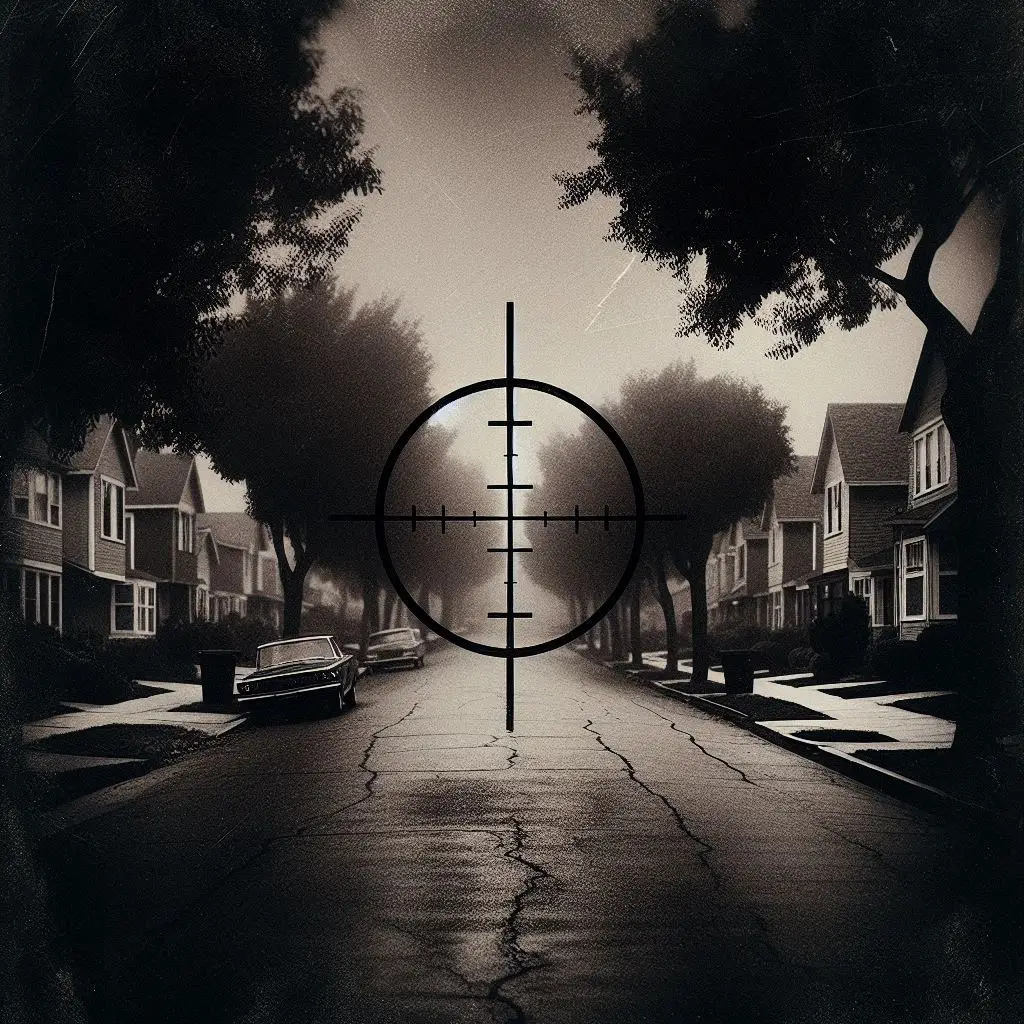It began with a letter.
On August 1st, 1969, three major newspapers in California—the San Francisco Chronicle, San Francisco Examiner, and Vallejo Times-Herald—each received an envelope.
Inside was a handwritten message from a man who claimed to have killed two people.
The letter was taunting, filled with strange symbols and demands. But the most chilling part wasn’t what he said—it was how he said it.
He signed it with a symbol: a circle with a cross through it.
And just like that, the Zodiac Killer was born.
A City in Fear
The late 1960s were supposed to be an era of peace and love in California—sunshine, protests, and hippies preaching “Make Love, Not War.” But that peace shattered one night in December 1968.
Two high school students, Betty Lou Jensen and David Faraday, parked their car on a quiet lovers’ lane outside Vallejo. It was their first real date.
Around 11:00 p.m., a gunman approached their car. He ordered them out and shot them both in cold blood.
There were no witnesses. No motive. No clues.
Seven months later, it happened again.
On the night of July 4, 1969, Darlene Ferrin and Mike Mageau were sitting in a parked car at Blue Rock Springs Park, just a few miles from the first attack. Suddenly, another car pulled up beside them. A man stepped out with a flashlight and a 9mm pistol.
He opened fire.
Mike was hit multiple times but somehow survived. Darlene wasn’t so lucky.
Less than an hour later, the Vallejo Police Department received a chilling phone call.
“I want to report a double murder,” the voice said calmly. “If you go one mile east on Columbus Parkway to the public park, you’ll find the kids in a brown car. They were shot with a 9mm Luger. I also killed those kids last year.”
The voice then hung up.
Police traced the call to a pay phone near a gas station. Fingerprints were found—but they didn’t match anyone.
And the killer wasn’t done talking.
The Letters
A few weeks later came the first of the infamous Zodiac letters—taunting, arrogant, and written with eerie precision. Each was marked with his crosshair symbol, and inside was a code: a cryptogram made up of 408 symbols.
The killer demanded that the newspapers print the letters on their front pages—or, he warned, “I will go on a kill rampage this weekend.”
The newspapers complied.
Within days, amateur codebreakers Donald and Bettye Harden, a schoolteacher couple from Salinas, cracked the first cipher. It revealed a chilling message:
“I like killing people because it is so much fun. It is more fun than killing wild game in the forest because man is the most dangerous animal of all.”
But even in his confession, the killer didn’t reveal his name.
He ended the message with, “I will not give you my name because you will try to slow down or stop my collecting of slaves for my afterlife.”
It was madness—and genius—wrapped in one.
The Lake Berryessa Attack
On September 27, 1969, college students Bryan Hartnell and Cecelia Shepard were picnicking at Lake Berryessa, about 50 miles north of San Francisco. The setting was peaceful: blue water, sunlight shimmering off the waves, quiet hills surrounding them.
Then they saw a man walking toward them.
He wore a hood. A black, executioner-style hood with a white crosshair symbol stitched on the chest. In his hand was a gun and a long knife.
He told them he had escaped from prison and needed their car and money to flee to Mexico. He spoke calmly, even politely, tying them up with rope.
Then, without warning, he stabbed them both—over and over.
Before leaving, he drew his symbol and the date of the murders on their car door, like a signature.
Bryan survived. Cecelia did not.
Later that night, the killer called the police again, from another pay phone.
“I want to report a murder. No, a double murder,” he said. “They were two miles north of park headquarters. I’m the one who did it.”
His voice was described as flat, emotionless, like someone ordering coffee.
The San Francisco Killing
Just two weeks later, the Zodiac struck again—this time, right in the city.
On October 11, 1969, cab driver Paul Stine picked up a fare near Union Square. The passenger asked to go to Presidio Heights, a wealthy neighborhood. When they arrived, Stine was shot point-blank in the head.
Three teenage witnesses saw the killer wiping down the taxi before calmly walking away.
Police arrived within minutes—but made a fatal mistake.
The dispatcher had mistakenly described the suspect as a Black man, based on a misunderstanding. The officers who passed a white man walking nearby—short hair, glasses, clean-cut—didn’t stop him.
They had just walked past the Zodiac Killer.
Later that night, another letter arrived. Inside was a piece of Paul Stine’s bloody shirt.
“School children make nice targets,” it read. “I shall wipe out a school bus some morning. Just shoot out the front tire and pick off the kiddies as they come bouncing out.”
For weeks, police guarded every school bus in the Bay Area. The city was paralyzed with fear.
The Codes That Never Spoke
The Zodiac sent more letters—over twenty in total—filled with ciphers, symbols, and bizarre ramblings about bombs and “slaves in paradise.”
But the most famous codes—the Z340, Z13, and Z32—remained unsolved for decades.
Each promised to reveal something. A name, a motive, or both.
In 2020, more than 50 years later, a team of private codebreakers finally cracked one of them—the Z340 cipher. It took advanced software and months of analysis.
The decoded message didn’t reveal his identity, but it confirmed one thing: the Zodiac was laughing at everyone.
“I hope you are having lots of fun in trying to catch me. I am not afraid of the gas chamber because it will send me to paradise all the sooner.”
Even in death, he wanted to be remembered.
The Suspects
Over the years, dozens of names have been tied to the Zodiac case. But three stand out above all others.
The first is Arthur Leigh Allen, a convicted sex offender from Vallejo. He was intelligent, socially awkward, and obsessed with codes. He owned the same type of watch that bore the Zodiac’s crosshair logo.
When police searched his home, they found animal blood, knives, and disturbing writings. But his handwriting didn’t match the letters. His fingerprints didn’t match the prints found on the envelopes.
He died in 1992—never charged.
The second major suspect, Rick Marshall, was a film projectionist who lived near San Francisco. He loved puzzles, owned an old movie projector similar to the one the Zodiac referenced in a letter, and used eccentric phrasing like the killer.
Again, no solid evidence.
Then there was Lawrence Kane, a Navy veteran with brain damage from a car accident and a history of stalking women. He lived near several victims and worked in the same building as one of them.
But despite countless investigations, none of these men were ever proven to be the Zodiac.
Every lead faded into smoke.
The Unending Puzzle
The Zodiac case isn’t just a murder mystery—it’s an obsession.
Law enforcement officers, amateur detectives, and internet sleuths have spent decades trying to piece together his ciphers, his clues, his handwriting.
There’s the symbol itself—a circle with a cross. Was it a target? A religious mark? An astrological sign?
There were references to movies, to The Most Dangerous Game, and to astrology. He quoted Shakespeare and talked about “paradise” and “slaves.” It was as if he wanted to be seen as an artist of fear.
But maybe the most haunting thing about the Zodiac was his silence.
After 1974, the letters stopped.
The killings—at least the confirmed ones—stopped too.
Some believe he was arrested for another crime. Others think he died.
But a few are convinced he simply faded away—watching the world chase his ghost.
The DNA Hunt
In the 2000s, forensic technology offered a new hope. DNA was extracted from the back of the Zodiac’s stamps and envelopes.
It wasn’t much—just trace material—but enough to create a partial profile.
Investigators compared it to thousands of suspects.
No match.
Then, in 2021, a volunteer group called The Case Breakers announced they had identified the Zodiac as Gary Francis Poste, a deceased Air Force veteran who lived in California.
They claimed his scars matched a sketch, and his name fit hidden clues in the letters.
But police quickly said the DNA didn’t match—and the case remains unsolved.
A Legacy of Fear
The Zodiac Killer didn’t just kill people—he rewrote the rules of fear.
He turned murder into a puzzle, taunted the media, and made the entire state of California his stage.
His crimes inspired movies, books, even other killers. He was the first true criminal of the information age—a man who understood how to use words and symbols to control the world’s attention.
Today, more than half a century later, you can still find online forums dedicated to decoding his messages. There are thousands of theories, new suspects, and endless debates.
But the truth remains buried—hidden behind letters and lies, laughter and loss.
Closing Thoughts
The Zodiac Killer wanted immortality.
In one of his last letters, he wrote:
“Me – 37. SFPD – 0.”
He wasn’t counting victims. He was keeping score.
And in a way, he won.
Because even now, over 50 years later, people are still reading his words, chasing his riddles, whispering his name.
We may never know who he was. We may never crack his final code.
But his shadow still lingers over California, over every cryptic letter, every unsolved mystery that followed.
And maybe that’s exactly what he wanted.
The perfect crime isn’t one that no one solves.
It’s the one everyone keeps trying to.




